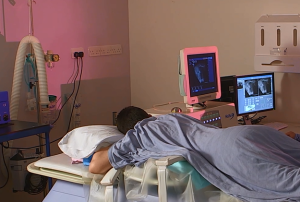Oxford spinout to use ultrasound to treat cancer and back pain

22nd January 2014
Oxford University Innovation announced that OxSonics has raised £2.7 million to develop therapeutic technology which uses ultrasound devices in combination with ultrasound-sensitive nanoparticles.
The technology can provide real-time on-screen feedback to the clinician about where and when drug delivery or surgery has been successful.
Lead researcher Professor Constantin Coussios of Oxford’s Institute of Biomedical Engineering, said: “What we discovered is that tiny bubbles can be triggered by ultrasound at the nanoscale to cause a wide range of therapeutic effects, ranging from improved drug delivery in tumours to non-invasive removal of the intervertebral disc. These bubbles can be used not only as promoters but also as markers of treatment.
“Ultrasound is best known for its diagnostic capabilities. For drug delivery, we will be using similar power settings to those used for conventional imaging applications.“
In a study published in the Journal of the National Cancer Institute, Oxsonics cofounders Professor Coussios, Dr Christian Coviello and Dr Robert Carlisle and their team showed that ultrasound can create tiny bubbles which ramp up the attack on tumours.
Coussios said: “A particular type of ultrasound-induced bubble activity, known as inertial cavitation, was found to be key – as bubbles collapse, they agitate the fluid around them, pumping anti-cancer drugs deeper into the tumours than ever previously reported.”
Compared to drug treatment without ultrasound, the team found that cavitation-enhanced delivery significantly hindered tumour growth and increased the survival rates of the mice being studied.
“Ultrasound can dramatically enhance delivery of drugs, particularly for next-generation therapeutics such as immune therapies or virotherapies,” said Coussios. “This focuses drug treatment at the site of the tumour, potentially reducing or avoiding damage to other parts of the body, a hazard associated with the use of chemotherapy drugs.”
Dr Colin Story, CEO of OxSonics said: “Metastatic liver cancer is the first clinical need we will aim to address. Every year there are 2.1 million new cases of this cancer in Europe and the United States combined. Unfortunately, only 5 to 10 per cent of cases can be treated by surgically removing the tumours. In the vast majority of the remainder, the illness is terminal.
“OxSonics technology can safely deliver drugs to the whole tumour, rather than a small portion of it. Our mission is to provide curative therapy to those patients who would otherwise be faced with a terminal illness.”
The company will also adapt the very same ultrasound technology, at a higher power setting, to surgically treat chronic lower back pain by repairing intervertebral discs. Lower back pain is one of the most common health problems in the developed world, affecting over 80 per cent of adults at some point in their life. OxSonics’ minimally invasive surgical approach could provide an alternative to highly invasive procedures such a spinal fusion.
Tom Hockaday, Managing Director of Oxford University Innovation, said: “The interest in OxSonics as an investment speaks to the strong portfolio of intellectual property built up around this technology by the University and Isis over the last six years and to the strength of biomedical engineering technologies here at Oxford. We now look forward to the technology being scaled up to deliver life-saving benefits to patients.”
The syndicated investment, led by Longwall Venture Partners, has been raised in a number of tranches and will be used by OxSonics to fund the clinical trials necessary to gain approval for its ultrasound devices.
Press release sign up

